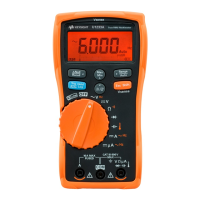U1231A/U1232A/U1233A User’s Guide V
• Inspect the test leads for damaged insulation or exposed metal.
Check the test leads for continuity. Replace damaged test leads
before you use the meter.
• Do not operate the meter around explosive gas, vapor, or wet
environments.
• Do not apply more than the rated voltage (as marked on the
meter) between terminals, or between terminal and earth ground.
• If the equipment is used in a manner not specified by the
manufacturer, the protection provided by the equipment may be
impaired.
• Never use the meter in wet conditions or when there is water on
the surface. If the meter is wet, ensure that the meter is dried only
by trained personnel.
• Before use, verify the meter's operation by measuring a known
source, for example, voltage.
• When measuring current, turn off the circuit power before
connecting the meter in the circuit. Remember to place the meter
in series with the circuit.
• When servicing the meter, use only the specified replacement
parts.
• Use caution when working above 60 V DC, 30 V AC rms, or 42.4 V
peak. Such voltages pose a shock hazard.
• Do not use the VZ
LOW
(low input impedance) function to measure
voltages in circuits that could be damaged by this function’s low
input impedance of 3 k
Ω.
• When using the probes, keep your fingers behind the finger
guards on the probes.
• Connect the common test lead before you connect the live test
lead. When you disconnect the leads, disconnect the live test lead
first.

